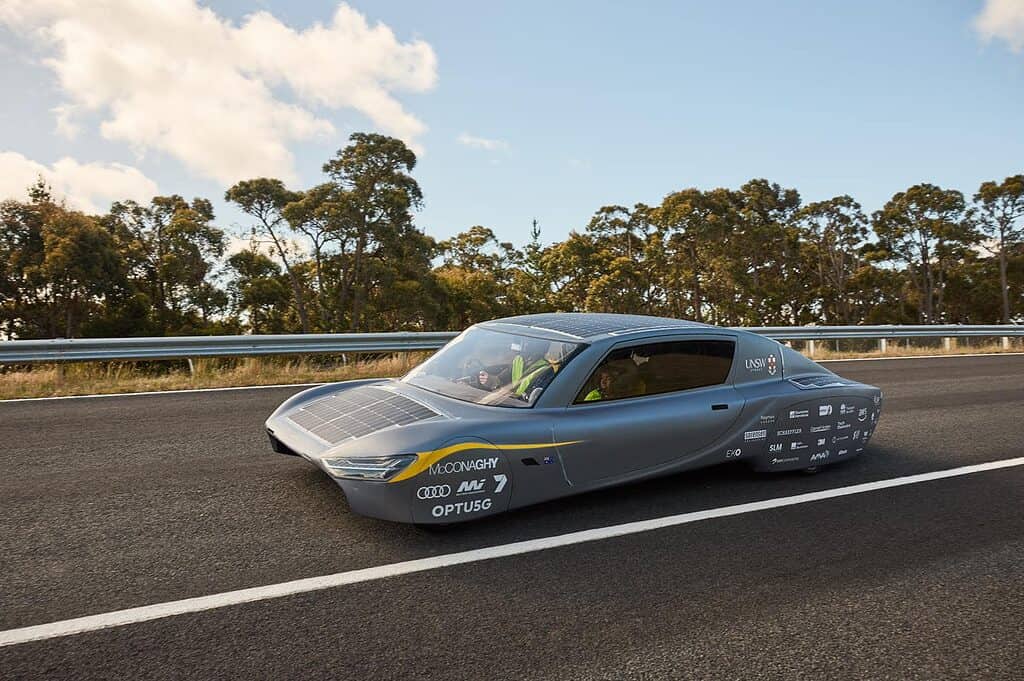Which electric cars do you think have the best range? If you’re thinking Tesla, think again because you’re not even close. The car that currently holds the title for the world’s longest-range EV is the Lucid Air Dream Edition R, with a certified range of 520 miles (804.6 km) per charge. However, you can go even further than that by using a trick: a solar car.
In case you need all the range you can get, then it’s time to read about the Sunswift 7, a solar-powered electric car that beats all the EVs on Earth when it comes to covering long distances.

Developed by a group of students at the University of New South Wales (UNSW) Sydney, Sunswift 7 looks as if it has time-traveled from the future to the year 2022. Recently, it made a Guinness World Record by covering a distance of 621 miles (1000 km) within 12 hours, on a single charge. That’s 101 miles beyond what is claimed by Lucid Dream Air and nearly 200 miles more range than what is offered by the Tesla Model S.
Although Sunswift 7 is not commercially available (its current design lacks basic components such as airbags, air conditioning units, windscreen wipers, and an anti-lock braking system) it’s still making waves, showing that we shouldn’t underestimate solar-powered EVs. In a world that’s witnessing the rise of electric vehicles with different kinds of battery systems ranging from lithium-ion to hydrogen fuel cells, solar cars may still have a place.
The car is a proof of concept more than something you can buy. UNSW’s Sunswift racing team principal and ex-head of operations at Red Bull Formula One Team, Richard Hopkins, said in the press release:
“Sunswift 7 isn’t a production car of the future, since we’ve compromised on comfort and the cost is prohibitive. But we have shown that if you want to make cars more efficient, more sustainable, and more environmentally friendly, then it is possible.”
Sunswift continues the legacy of breaking records
Sunswift 7 set the world record by traveling 1,000 km in 11 hours 52 minutes and eight seconds. During its journey, the car had an average speed of 85 km/hr (52.8 mph), making it the fastest EV with a 1000 km range. It completed a total of 240 laps of the Australian Automotive Research Centre (AARC) Highway Circuit and only stopped to change the driver or the tires, or for maintenance checks.
The UNSW team has tried to apply the engineering principles employed in F1 cars to make Sunswift a high-performance long-range vehicle.
“I used to work in Formula One and nobody thinks we’ll be driving F1 cars on the road in five or 10 years. But the technology they use in F1 really pushes the boundaries and some of that filters down [to regular vehicles] and that’s what we are trying to do with Sunswift and what this world record shows is achievable,” explained Professor Hopkins.
However, this is not the only vehicle from UNSW’s Sunswift team that’s great at breaking records. Sunswift 7’s predecessor — the Solarswift Violet was the Guinness world record holder for the world’s most energy-efficient EV in 2018.
Interestingly, the story doesn’t end here. Before Violet, there was the Sunswift 5 EV that covered 500 km on a single charge, and that too while maintaining an average speed of 107 km per hour. This car broke a record that was unbeaten for 26 years. For its incredible performance, the International Automobile Federation named Sunswift 5 the world’s fastest EV in 2014.
Now with double the range of the 2014 model, Sunswift 7 has successfully managed to continue the trend set by its predecessors. What’s more surprising is that all these extraordinary solar EVs from Sunswift Racing are developed by a group of college students from scratch. Even in the middle of the 1000 km journey, a problem suddenly popped up in the car’s battery system.
The students were required to solve this issue within 15 minutes to break the previous Guinness record, and they did it exactly eight seconds before the deadline.
“Let’s remember, these are not the best-paid professional car makers in Stuttgart working for Mercedes. This is a bunch of very smart amateurs who have taken all the ingredients and put it together in a brilliant way,” said Professor Hopkins.
More power with less energy
Sunswift 7 captures solar energy through the solar panels embedded into its chassis. There are solar panels on the roof, on the sides, and in the front. Forget the 1000 km range, even if you were to compare it against the most efficient EVs in terms of energy consumption the difference will blow your mind.
According to the UNSW team, a typical EV consumes 20 kWh of energy for traveling every 100 km trip. Even the most efficient electric cars will require at least 15 kWh for traveling the same distance. Can you guess the energy consumption of Sunswift 7? It’s 3.8 kWh per 100 km which makes it almost 75 percent more efficient than the most efficient EVs currently available on the market.
However, we are yet to see a commercially available solar-powered EV like Sunswift 7. A solar EV with an incredible range and all the amenities found in a normal car. Energy consumption figures might vary then, but for now, Sunswift 7 has shown us the wonderful rewards of using solar energy in automobiles.
You can read the original UNSW press release here.









